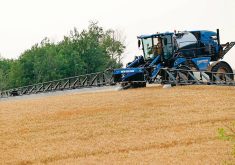In early July, Manitoba Pork Council general manager Cam Dahl submitted an opinion piece to the Co-operator, arguing that Canada’s product approvals process puts producers at a competitive disadvantage.
“Farmers in competing countries like the U.S. have rapid access to new products and technologies, while the slow pace of regulatory approval in Canada can block our farmers’ access to innovation,” he wrote.
“In too many cases, companies that bring new products forward do not even apply to Canada because of the cost and time involved in navigating the regulatory system.”
Read Also

Calling all Co-operator readers
Hey farmers, we want to hear your Manitoba Co-operator stories: the articles that stuck out, the farm history you watched on our pages.
He further argued that Health Canada’s refusal to accept the research used to approve products in “other countries with a robust regulatory approval system, like the U.S.,” is doing little to close the gap.
Dahl and the pork industry aren’t the only ones frustrated. It only takes a mention of the Pest Management Regulatory Agency to dampen a conversation between farmers. Part of that is the agency’s raison d’être. No one likes the hall monitor, even if they can respect why the role exists.
There are good and necessary reasons for a stringent approvals process. Not all of them are detrimental to the industry. Canadian agriculture is an export business. The same regulations that can irk agriculture also help build international confidence in Canadian standards and help position this country as a trading partner.
That reasoning conflicts with the plodding inefficiency that organizations like the PMRA are often accused of. There is significant resentment around the slog of getting any product approved, especially when farmers can see their U.S. counterparts using the same tool across the proverbial fence line.
Regulatory revamps are slow and often critically out of date before any change is made. As Alexis Kienlen reported earlier this month, the Canadian Food Inspection Agency has finally released a new set of feed regulations — 14 years after industry asked for an update. The last set was based on the best scientific knowledge and technology available, circa 1983.
Drone spraying is another example. As Miranda Leybourne reported in early June, agriculture is getting fed up with lack of regulatory movement to get drones added to pesticide labels.
In the U.S., drone spraying gets mostly the same treatment as other aerial application. Here, Health Canada has said drones are not planes and it doesn’t have enough data to make drone-specific risk assessments.
It’s not necessarily wrong. Tom Wolf, who owns Agrimetrix Research and Training and might be one of the most cited spray experts on the Prairies, told the Western Producer earlier this year that drones are “nothing like anything we’ve ever seen before in terms of how they spray, how they deposit the spray, how they’re operated.”
Smaller tanks mean lower water volumes, finer droplet size and potentially more drift, he added.
In the same article, a representative of a PMRA drone working group pointed out that a smaller tank means more refills and more handling and chemical exposure.
If Health Canada needs data, fine, but the amount of work done in the last few years seems a far cry from the scope of what needs to be done. Like Dahl noted, Canadian authorities aren’t really interested in taking data generated elsewhere.
Meanwhile, enthusiasm for the technology is growing and farmers are getting mixed messages. With very few exceptions, spraying pesticides via drone remains illegal in Canada, but you’d never know that based on the number of times spray drones are promoted. The reasons for caution, as noted by experts like Wolf, are quietly in the background.
To most farmers, the whole regulatory discussion about drones seems dead in the water and the apparent lack of movement puts Health Canada at risk of being overtaken by events.
Spray drones would certainly have made life easier in Manitoba in the last few weeks. Fewer sprayers would have been stuck.
“Rain, wet fields and high winds have been severely limiting herbicide operations,” Manitoba Agriculture’s July 4 pest report noted. “Weeds may have advanced beyond the recommended stage for weed control as farmers were not able to get on the fields as early as they planned.”
Many who did get into the field will now deal with ruts for the rest of the season.
Innovation is critical to the future of agriculture, especially if there’s more volatile weather on the horizon, as we’ve been told to expect. Farmers will need as many tools as possible to pivot quickly and adapt on the fly.
That will be difficult, however, if the approvals process for those innovations isn’t also streamlined and responsive.
















